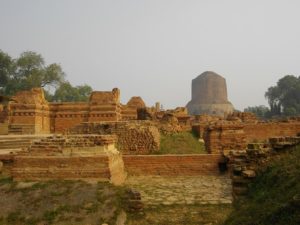
Ruins Buddhist monasteries-Dhamekh Stupa Sarnath – courtesy Yusuke Kawasaki
Sarnath Museum
I enjoyed a visit to this ancient site, and the nearby Deer Park at Sarnath. The Archaeological Museum at Sarnath has a beautiful interior, laid out similar to a monastery with a central hall, five galleries and two verandas; antique relics and sculptures arranged for clear viewing. The museum houses some of the greatest treasure of Indian Buddhist art, ranging from 3rd century BCE to 12th century AD, all found at Sarnath archaeological site. Stone panels on the life of the Buddha and many ancient Buddha statues are there to see.
In Gallery 3 at Sarnath Museum you will find the most famous piece of sculpture in polished sandstone, this is the superb Capital from the Ashokan Pillar – the Ashokan symbol of four back-to-back Lions, now adopted as the state symbol of Independent India.The remains of the Ashokan Pillar found in pieces on site, but amazingly the Lion Capital survived intact after its fall from the top of the pillar, the base of the pillar still stands in its original spot. There are eight beautiful Buddha statues made from stone in this gallery alone.
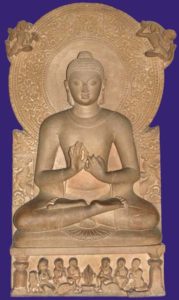
In Gallery 1. at the Sarnath Museum you will find one of the earliest images of the Buddha exquisitely carved in stone, worth the visit just to see this piece. Incredibly beautiful, it dates from the Gupta Period. 5th cent. C.E. The Gupta Empire, an ancient Indian empire founded by Sri Gupta. This period called the Golden Age of India reaching its peak between 320-550 CE, stretching across much of the Indian subcontinent. It was a time of peace and prosperity and the Gupta rulers encouraged the pursuit of scientific, religious and artistic endeavors.
![By Jonas Maria E. at English Wikipedia [Public domain], via Wikimedia Commons](https://www.terrafirmatourist.com/wp-content/uploads/2016/11/1024px-Dharmarajika_Stupa-300x225.jpg)
Dharmarajika_Stupa-pre-Ashokan Era-courtesy Jonas Maria E.
Dharmachakra Stupa
Sarnath is a sacred site for Buddhists. The Buddha came to the Deer Park in 528 BC to deliver his first sermon on the Dharmachakra Stupa or the Wheel of Law after his enlightenment. Today only the foundation of the Stupa can be seen, which is still impressive and considered a rare pre-Ashokan Stupa. Ashoka, one of India’s greatest Emperors of the Maurya Dynasty. who ruled almost all the Indian subcontinent from c.268 to 232 BCE.
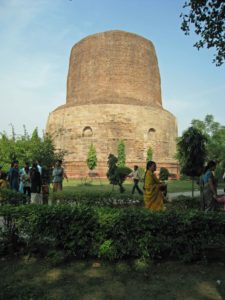
Dhamekh Stupa, Sarnath
The most important monument in the Archaeological Park at Sarnath is the 5th century AD Dhamekh Stupa, built at the site where the Buddha is believed to have delivered his first sermon to five disciples.
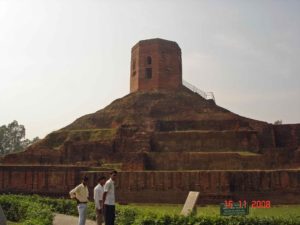
The Chaukhandi Stupa, a terraced temple of the Gupta period is the site where Lord Buddha met his first disciples traveling from Bodh Gaya to Sarnath. An octagonal tower added to the stupa in the 16th Century to commemorate the visit of Mughal Emperor Humayun.
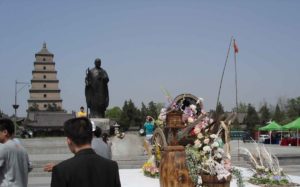
Statue of Hsüan-tsang or Xuánzàng-Wild Goose Pagoda Xian
India’s greatest center of learning at Sarnath
Sarnath became one of India’s greatest center of learning for Buddhism. Visited by two famous Chinese travelers/monks Fa-Hsien (Faxian) between the years 399-412 to acquire Buddhist texts and learning. The second famous monk, Hsüan-tsang or Xuánzàng, traveled overland from China to India via the Gobi Desert, then westward following the Tian Shan mountain range. The monk arrived in India around 630 BC reaching Sarnath in 637 BC, where he found 30 monasteries and 3,500 monks in residence. Hsüan-tsang spent 28 years travelling, collecting Buddhist documents and texts to translate into Chinese and traversed the Indian continent in all directions. Zuanzang returned to China in 645 BC. It is hard to imagine such a journey on foot.
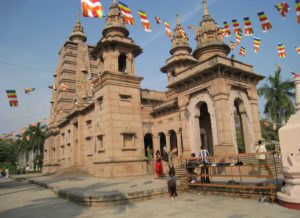
Modern Mulagandhakuti Vihara, Sarnath
Restoration and excavations at Sarnath
Turkish Muslims sacked the site at Sarnath at the end of the 12th century; buildings and structures damaged or destroyed. The site then plundered for building materials. It remained in ruins until 1836 when the British, recognizing its significance as a religious and historical archaeological site, began excavations and restoration on the site.
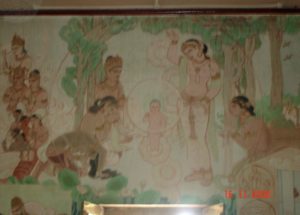
Temple Frescoes on the life of the Buddha
Mulagandhakuti vihara
The ruins of the ancient Mulagandhakuti vihara (monastery) lie in the archaeological site at Sarnath and mark the place where the Buddha spent his first rainy season.
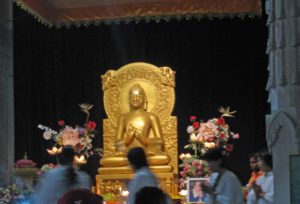
To the east of the site is the modern Mulagandhakuti Vihara, a monastery/temple built in the 1930’s by Sri Lankan Mahabodhi Society as the prime place of worship in the world for the Buddhist community. It has beautiful wall paintings by a famous Japanese artist of the time, Kosetsu Nosu, depicting the important events in the life of the Buddha. In the inner sanctum is a seated, life-size golden statue of the Buddha.
The Deer Park
Behind the Vihara lies the Deer Park, maintained as a sanctuary for deer. The Lord Buddha preached his first sermon here, it is known as ‘The Sermon in the Deer Park“. Deer can still be seen roaming freely in the Park. It is a very quite and peaceful area.
Sarnath is 10km NE of Varanasi.
Archaeological Museum open Sat-Thu.
Related Posts:
Sarnath Museum is a historical place i love this place so much……